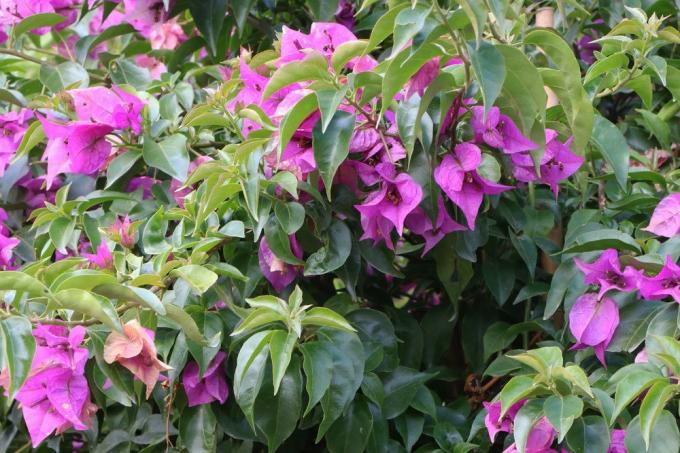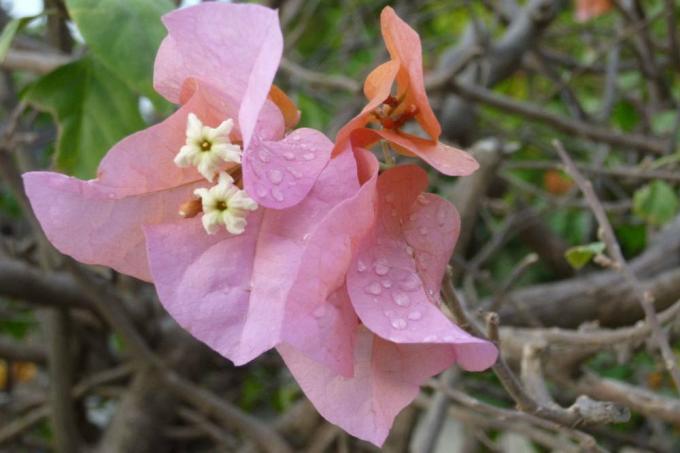
table of contents
- Cut
- Autumn cut
- Winter quarters
- Cut time
- Cutting instructions
- Shoots
The bougainvillea (also called bougainville or triplet flower) is a subtropical plant that enchants us with its play of colors in summer. The bright colors do not come from the flowers, but from the three bracts surrounding them. Botanically, the bougainville belongs to the miraculous flower family. The bougainville does not have any special requirements when it comes to care. However, it must be cut regularly. However, since it is well tolerated by pruning, the pruning can also be carried out by less experienced plant enthusiasts.
Cut
The bougainville is not only one of the plants that are compatible with pruning, it can also be pruned at different times. Usually the shrub or tree is pruned in spring, summer and autumn. This gives the bougainvillea enough time to recover between the blending. And it can close the cut surfaces.
A good time to prune is in autumn or spring. However, the spring pruning must be carried out before the plant begins to sprout again. If this point in time has been missed, pruning should be avoided in spring, as otherwise the bougainville will not develop any flowers. If you cut too late in spring, you will also have to do without the colorful bracts, which are the real charm of the plant. If no pruning could be carried out in spring, it should definitely be pruned in autumn, as the summer pruning is mainly used to keep the bougainville in shape. That is why there is not too much pruning in summer.

Autumn cut
All of the bougainvillea species that we cultivate originally come from subtropical regions. That is why we keep the non-winter-hardy plant in the bucket and it must be moved to the “warm” winter quarters (at 10 degrees Celsius) before the first frost. The autumn pruning is therefore best done before the move.
The aim of the autumn pruning is:
- to "shrink" the plant
- the removal of the long whip shoots
- the trimming and cutting out

Winter quarters
Place in winter quarters
Many plant lovers know the problem: No matter how well you plan, the winter quarters for the balcony and terrace plants are actually always too small. That is why the autumn pruning of the triple flower can also be done for pragmatic reasons. The plant loses height and width and therefore needs less space in its winter quarters. Bougainville blossoms and bracts grow on so-called whip shoots. These shoots become very long, which pleases us in the summer during flowering. Because they make the plant look so colorful and lush. Since they are more of an obstacle in winter because of their length, they are shortened.

Personal experience: shortening does not mean radical cutting back. Such a drastic measure is also difficult to cope with the cut-compatible bougainville. In addition, the bougainvillea is cleaned. Cutting out the inside will make the plant lighter. This gives branches and twigs inside the plant more light and air. The latter also prevents infestation by pests during the winter, which like to nestle in very dense shoots.
Cut time
Time for the autumn pruning
Since the bougainvillea needs some time to recover from the pruning, don't wait until the last minute of the outdoor season to start pruning. Because the cold that enters the plant through the open areas can also damage it. In addition, a rainy day should not be chosen for the cut. It is best to cut the plant on a sunny day when cold temperatures are not expected at night.
Tip: The later the autumn pruning, the later the flowering will start in the coming year.
Cutting instructions
Since the bougainville forgives many cutting mistakes, even those who are less experienced with cutting should get along well. The right tool is important for every cut.
- sharp and clean secateurs
- Be sure to clean before cutting
- Disinfect secateurs if plants with pest infestation have been cut beforehand

The individual cuts must be made vigorously. Each branch should be severed with a single cut. A smooth, vertical cut is best for the plant. This keeps the cut as small as possible. There is less rainwater on the wound. And the plant can close the open area faster. Because every cut itself is a gateway for pests. In addition, the plant is slightly weakened, which also makes it more susceptible to pests.
Tip: If a cut is not so accurate, start another cut a little further down. In no case should you just tear off the branch or twig. This is a serious injury from the plant's point of view.
The triple flower does not need a special wound closure. If all cuts are successful, the plant will heal itself. This means that the cut surfaces dry out and become lignified.

Shoots
Main and secondary shoots
In the case of shrubs, trees and climbing plants, a distinction is made between main and secondary shoots. Main shoots are always thicker than secondary shoots. These must not be cut off as they form the healthy substance of the plant. Side shoots can definitely be cut back more, but not more than halfway.
Whip shoots and young shoots
To encourage flower formation for the coming year, all young or whip shoots with withered flowers should be cut back before moving to the winter quarters. Because on these often very long shoots no flowers will form in the coming year. As a rule, they are only developed by the plant on the short shoots.

Deadwood
Dead wood or dead wood should be removed when pruning in autumn. Dead wood does not form new shoots and looks dry and dry in appearance. Often these branches break off almost on their own. When cutting off dead wood, the living wood is cut so that the plant can heal the wound.
Tip: In contrast to dead wood, living wood has a green color under the bark. If in doubt, it is best to pinch off some of the bark and look. If there is no lush green, it is dead wood.



